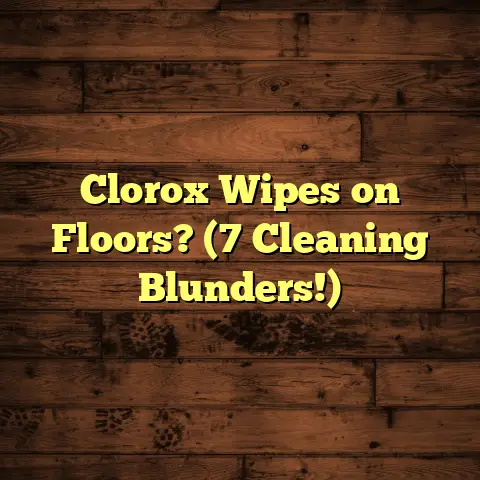Remove Ammonia Smell From Floor? (4 Odor Hacks!)
It’s more common than you might think, especially in homes with pets, frequent spills, or poor ventilation.
But don’t worry, I’m here to share some expert tips and tricks to help you kick that ammonia smell to the curb!
Expert Tip:
One of the most effective ways to combat ammonia odors from floors, especially in homes with pets, is to immediately address spills and accidents with a proper cleaning solution.
Experts recommend using a mixture of white vinegar and water as it neutralizes ammonia and eliminates the odor efficiently.
This solution not only cleans the surface but also penetrates the flooring material to tackle the root of the smell.
Section 1: Understanding Ammonia Odors in Flooring
So, what exactly is ammonia, and why does it decide to hang out in our floors?
Ammonia is a compound of nitrogen and hydrogen (NH3).
It’s a colorless gas with a strong, pungent odor.
Think of that sharp, eye-watering smell.
It’s a natural byproduct of decomposition, and it’s also found in many household products.
But how does it end up embedded in your flooring?
Pet Urine: This is probably the most common culprit.
Pet urine contains urea, which bacteria break down into ammonia.
Accidents happen, but if not cleaned properly, that ammonia smell can linger.Household Spills: Certain cleaning products, fertilizers, and even some drain cleaners contain ammonia.
Spills can seep into porous flooring materials.-
Poor Ventilation: If your home isn’t well-ventilated, ammonia fumes from various sources can build up over time, especially in enclosed spaces like bathrooms or basements.
Now, different flooring types react differently to ammonia. Let’s break it down:
-
Tile: Tile is generally resistant to ammonia, but the grout lines are porous and can absorb odors.
Hardwood: Hardwood is more susceptible to damage.
Ammonia can stain and warp the wood if left untreated.-
Laminate: Laminate is relatively resistant, but the seams can be vulnerable to moisture and odor absorption.
Carpet: Carpet is like a sponge for odors.
Ammonia can penetrate deep into the fibers, making it tough to remove.
Have you ever noticed how a small spill can suddenly make a whole room smell?
It’s because the flooring material is trapping those ammonia molecules.
Section 2: The Importance of Immediate Action
Why is it so crucial to tackle ammonia smells ASAP?
It’s not just about the unpleasant odor.
Prolonged exposure to ammonia can have some serious consequences:
-
Long-Term Floor Damage: Ammonia can corrode and stain certain flooring materials, leading to discoloration, warping, and even structural damage.
Health Impacts: Ammonia fumes can irritate the eyes, nose, and throat.
In high concentrations, it can cause respiratory problems, especially for people with asthma or other breathing conditions.- According to the Agency for Toxic Substances and Disease Registry (ATSDR), exposure to high levels of ammonia in the air can cause immediate burning of the eyes, nose, throat, and respiratory tract and can result in blindness, lung damage, or death.
(https://www.atsdr.cdc.gov/substances/toxsubstance.asp?toxid=8)
- According to the Agency for Toxic Substances and Disease Registry (ATSDR), exposure to high levels of ammonia in the air can cause immediate burning of the eyes, nose, throat, and respiratory tract and can result in blindness, lung damage, or death.
Mold Growth: Lingering moisture from spills, combined with poor ventilation, can create the perfect environment for mold growth.
Mold not only smells bad but can also pose serious health risks.
I remember one case where a homeowner ignored a persistent ammonia smell in their basement for months.
Turns out, a leaky pipe was causing moisture to seep into the carpet, leading to a massive mold infestation.
They ended up having to replace the entire flooring and remediate the mold, costing them thousands of dollars.
Don’t let that be you!
Addressing ammonia odors quickly can save you a lot of headaches (and money) in the long run.
Section 3: Hack #1 – Vinegar and Water Solution
Alright, let’s get to the good stuff: the odor hacks!
First up is the trusty vinegar and water solution.
This is my go-to for tackling mild to moderate ammonia smells.
Why Vinegar Works: Vinegar contains acetic acid, which neutralizes ammonia.
It’s a natural deodorizer and disinfectant, making it a safe and effective cleaning agent.
Recipe:
- 1 part white vinegar
- 1 part water
Instructions:
- Mix: Combine the vinegar and water in a spray bottle or bucket.
- Test: Before applying to the entire floor, test the solution on a small, inconspicuous area to ensure it doesn’t damage the finish.
- Apply: Spray or mop the solution onto the affected area.
- Scrub: Gently scrub the floor with a soft brush or cloth.
- Wipe: Wipe away the excess solution with a clean, damp cloth.
- Dry: Allow the floor to air dry completely.
Flooring Type Considerations:
-
Tile: This solution works great on tile. Pay extra attention to the grout lines.
Hardwood: Use a slightly diluted solution (more water than vinegar) and avoid soaking the wood.
Wipe up any excess liquid immediately.-
Laminate: Similar to hardwood, use a diluted solution and avoid excessive moisture.
Carpet: Spray the solution lightly onto the carpet, being careful not to saturate it.
Blot with a clean cloth and allow it to dry thoroughly.
You might need to repeat this process a few times for stubborn odors.
I’ve seen this simple solution work wonders on countless floors.
It’s cheap, eco-friendly, and effective.
Section 4: Hack #2 – Baking Soda Absorbent Method
Next up, we have baking soda, the ultimate odor absorber.
Baking soda (sodium bicarbonate) has a unique ability to neutralize odors rather than just masking them.
How it Works: Baking soda is amphoteric, meaning it can react with both acids and bases.
It absorbs odors by drawing them into its porous structure.
Instructions:
- Sprinkle: Generously sprinkle baking soda over the affected area.
- Wait: Allow the baking soda to sit for at least 4-6 hours, or preferably overnight.
The longer it sits, the more odors it will absorb. - Vacuum: Vacuum up the baking soda thoroughly.
Timeline:
- Light Odors: 4-6 hours
- Moderate Odors: Overnight
- Strong Odors: 24-48 hours
Flooring Type Considerations:
Tile: Baking soda works well on tile and grout.
You can even make a paste of baking soda and water to scrub stubborn stains.-
Hardwood: Baking soda is generally safe for hardwood, but avoid rubbing it in too vigorously, as it can scratch the finish.
-
Laminate: Similar to hardwood, be gentle when applying baking soda to laminate.
Carpet: This is where baking soda really shines.
Work the baking soda into the carpet fibers with a brush before letting it sit.
I often recommend this method for carpets, especially after using the vinegar and water solution.
It helps to absorb any lingering moisture and odors.
Section 5: Hack #3 – Essential Oils and Natural Odor Neutralizers
Now, let’s add a little aromatherapy to our odor-fighting arsenal!
Essential oils not only smell great but also have natural antibacterial and deodorizing properties.
Essential Oils for Odor Control:
- Lavender: Known for its calming and deodorizing properties.
- Lemon: A natural disinfectant and deodorizer with a fresh, citrusy scent.
- Tea Tree: Has antibacterial and antifungal properties, making it great for combating mold and mildew.
- Eucalyptus: A strong deodorizer with a refreshing scent.
DIY Cleaning Solution:
- 1 cup water
- 1/2 cup white vinegar
- 10-20 drops of your favorite essential oil
Instructions:
- Mix: Combine the ingredients in a spray bottle.
- Test: As with the vinegar solution, test on a small, inconspicuous area first.
- Apply: Spray the solution onto the affected area.
- Wipe: Wipe away the excess solution with a clean, damp cloth.
- Dry: Allow the floor to air dry completely.
Safety Precautions:
- Dilution: Always dilute essential oils before applying them to your floors.
- Pet Safety: Some essential oils can be toxic to pets.
Do your research before using them around your furry friends. - Allergies: Be mindful of any allergies you or your family members may have to certain essential oils.
I love using essential oils in my cleaning routine.
They not only eliminate odors but also leave my home smelling fresh and inviting.
Just be sure to use them safely and responsibly.
Section 6: Hack #4 – Commercial Odor Eliminators
Sometimes, you need to bring in the big guns.
Commercial odor eliminators are specifically designed to tackle tough ammonia smells.
Types of Commercial Odor Eliminators:
Enzyme Cleaners: These contain enzymes that break down the organic compounds that cause odors.
They’re particularly effective for pet urine.-
Odor Neutralizers: These products contain chemicals that react with odor molecules, neutralizing them.
Air Fresheners: These simply mask odors with fragrance.
While they can provide temporary relief, they don’t eliminate the source of the smell.
Popular Brands:
- Nature’s Miracle: A popular enzyme cleaner for pet odors.
- Febreze: Offers a variety of odor-eliminating products, including fabric refreshers and air fresheners.
- OdorBan: A concentrated odor eliminator that can be used on a variety of surfaces.
User Testimonials:
“Nature’s Miracle saved my carpets after my puppy had a few accidents.
The ammonia smell was gone within hours!” – Sarah J.“I use Febreze Fabric Refresher on my furniture and carpets to keep them smelling fresh.
It’s a quick and easy way to eliminate odors.” – Michael B.
Effectiveness, Cost, and Application Methods:
When using commercial odor eliminators, always follow the manufacturer’s instructions carefully.
And as with any cleaning product, test on a small, inconspicuous area first.
Section 7: Preventative Measures
Okay, we’ve covered how to get rid of ammonia smells, but what about preventing them in the first place?
Here are some tips to keep your floors smelling fresh:
-
Regular Cleaning: Establish a regular cleaning routine to prevent spills and accidents from lingering.
Proper Ventilation: Ensure your home is well-ventilated, especially in areas prone to moisture and odors.
Open windows and use exhaust fans.-
Mats and Rugs: Place mats and rugs in high-traffic areas to protect your floors from spills and dirt.
-
Pet Training: Train your pets to eliminate outdoors and clean up accidents immediately.
-
Absorbent Materials: Use absorbent materials, like puppy pads or litter boxes, to contain pet waste.
-
Prompt Spill Cleanup: Address spills immediately with the appropriate cleaning solution.
-
Choose Flooring Wisely: When selecting new flooring, consider materials that are resistant to stains and odors.
I always tell my clients that prevention is the best medicine.
By taking these simple steps, you can keep your floors clean, fresh, and odor-free.
Conclusion
So, there you have it: my top 4 odor hacks for removing ammonia smells from your floors.
From the trusty vinegar and water solution to the power of baking soda, essential oils, and commercial odor eliminators, there’s a solution for every situation.
Remember, addressing ammonia odors promptly is crucial for preventing long-term damage and maintaining a healthy home environment.
Don’t let that pungent smell linger!
I encourage you to try out these hacks and share your experiences.
What works best for you?
Do you have any other tips or tricks for combating ammonia odors?
Let’s start a conversation and help each other keep our floors smelling fresh and clean!





